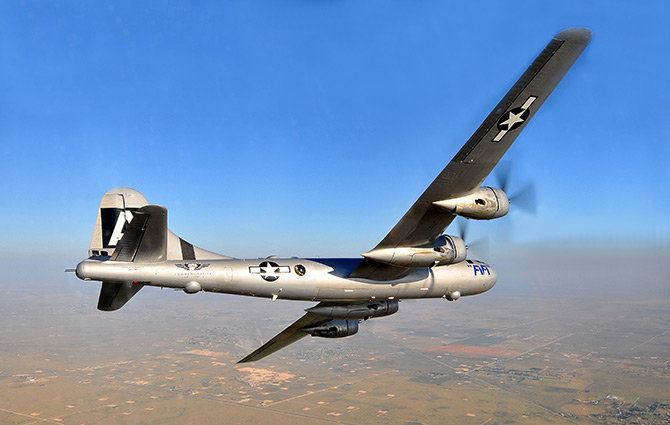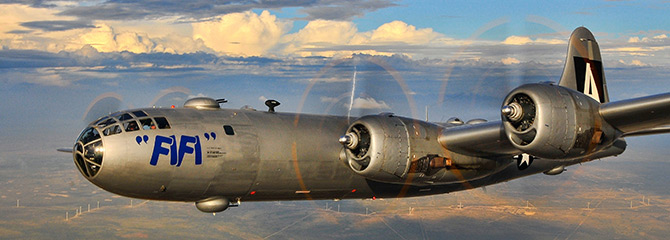
Photography by Scott Slucum and Jim Wilson
The heavily laden B–29 taxied slowly toward Runway Able, one of four parallel runways clustered at North Field on the northern tip of Tinian, a tiny green dot floating on the Pacific vastness. The flight, designated as Dimples 82, was cleared for takeoff.
Col. Paul Tibbets steered the Superfortress onto the asphalt and crushed-coral runway. None of his 11 crewmembers knew the exact nature of this mission, and they would not know until after takeoff. There were uncertainties about this flight, explaining why in one pocket he carried a small box containing 12 cyanide tablets.
Lined up with the runway, Tibbets “stood” the throttles, “walking” them differentially to keep the nosewheel on the centerline. When the tall rudder began to bite the air at 60 to 65 mph, he gave command of the throttles to his flight engineer, Wyatt Duzenberry, who set maximum power.
So precious and critical was the sextant on this flight that the navigator, Theodore Van Kirk, held and cushioned it in his lap.
At 130 mph Tibbets gingerly raised the nose just enough to elongate the nosewheel strut. The Superfortress sniffed the tropical night sky and consumed almost the entire 8,500-foot-long runway reaching 155 mph. At 02:45 local time on August 6, 1945, the Enola Gay pushed the ground away and lifted thunderously into the darkness for a rendezvous with destiny.
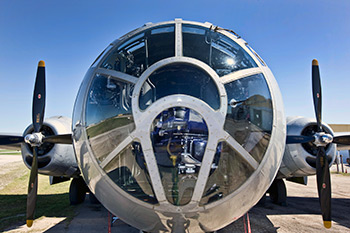
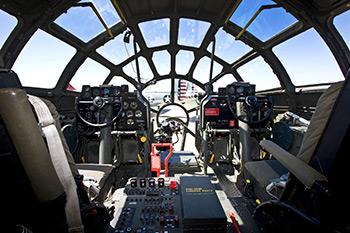
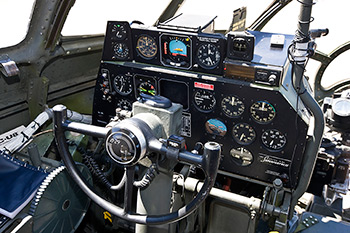
The Boeing B–29 Superfortress first flew on December 30, 1942, and was the largest, most technically advanced bomber of the war. It could fly 3,200 miles at more than 300 mph while carrying a 20,000-pound payload. Its efficient, unusually slender wings enabled it to penetrate deep into the heart of enemy territory at 36,000 feet, above the effectiveness of antiaircraft fire.
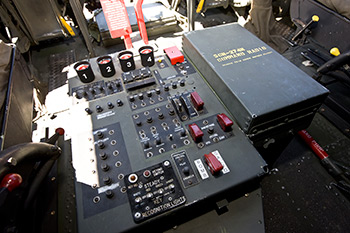 Defensive weaponry consisted of five remotely controlled, electrically driven gun turrets. The guns were fired by gunners who had no direct contact with their weapons. Each turret had two .50-caliber machine guns, and the tail turret also had a 20-mm cannon. The airplane carried two tons of ammunition ready for firing.
Defensive weaponry consisted of five remotely controlled, electrically driven gun turrets. The guns were fired by gunners who had no direct contact with their weapons. Each turret had two .50-caliber machine guns, and the tail turret also had a 20-mm cannon. The airplane carried two tons of ammunition ready for firing.
Pneumatically operated bomb-bay doors opened in less than a second and closed in three, reducing the time that open doors slowed the airplane during a bomb run. The forward and center fuselage compartments were pressurized (then called “cabin supercharging”). They were connected with a 30-foot-long, crawl-through tube above the bomb bays. The tail gunner’s position also was pressurized but he could not enter or leave his station while it was under pressure. With a maximum pressure differential of 6.6 psi, the B–29 could maintain an 8,000-foot cabin altitude up to 30,000 feet. From 30,000 to 40,000 feet, cabin altitude increased to 12,000 feet. The B–29 was depressurized during combat, and the crew used oxygen masks and electrically heated flight suits.
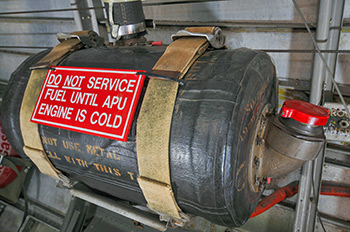 Almost everything aboard the Superfortress was operated electrically, including the landing gear, flaps, propellers, and cowl flaps. Electrical systems were considered less vulnerable to enemy fire than hydraulic systems. The airplane had six engine-driven generators plus a small auxiliary power unit (APU), a 15-horsepower, two-cylinder engine (called the “putt-putt”) that drove a seventh generator. Only the brakes were hydraulic. The APU provided electrical power for starting those huge engines. It also was used while taxiing to power the electric hydraulic pump for the brakes. Otherwise, braking could drain the battery. Each twin-row, 18-cylinder Wright Cyclone R-3350-23 radial engine developed 2,200 horsepower, and each had an internal supercharger fed by a pair of turbochargers providing sea-level power up to 33,000 feet.
Almost everything aboard the Superfortress was operated electrically, including the landing gear, flaps, propellers, and cowl flaps. Electrical systems were considered less vulnerable to enemy fire than hydraulic systems. The airplane had six engine-driven generators plus a small auxiliary power unit (APU), a 15-horsepower, two-cylinder engine (called the “putt-putt”) that drove a seventh generator. Only the brakes were hydraulic. The APU provided electrical power for starting those huge engines. It also was used while taxiing to power the electric hydraulic pump for the brakes. Otherwise, braking could drain the battery. Each twin-row, 18-cylinder Wright Cyclone R-3350-23 radial engine developed 2,200 horsepower, and each had an internal supercharger fed by a pair of turbochargers providing sea-level power up to 33,000 feet.
Although 3,970 “Superforts” were built, none was airworthy in 1966 when the Commemorative Air Force (nee Confederate Air Force) began looking to acquire one for its collection of World War II aircraft. The Pentagon said that none were in inventory or storage. In 1971, however, a pilot reported sighting what looked like B–29s parked in the desert near China Lake, California. The military said, however, that it would not part with any of these derelict aircraft, even though they had been abandoned for 17 years.
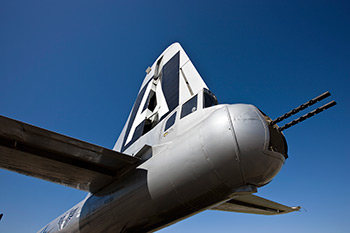 CAF supporter Victor Neils Agather spearheaded an acquisition effort and enlisted the aid of then-Arizona Sen. Barry Goldwater. The military relented, and the CAF was permitted to take its pick of the lot. Aircraft 44-6207 was selected, a bomber that originally had been delivered to the U.S. Army Air Corps on July 31, 1945, and removed from service only 11 years later.
CAF supporter Victor Neils Agather spearheaded an acquisition effort and enlisted the aid of then-Arizona Sen. Barry Goldwater. The military relented, and the CAF was permitted to take its pick of the lot. Aircraft 44-6207 was selected, a bomber that originally had been delivered to the U.S. Army Air Corps on July 31, 1945, and removed from service only 11 years later.
In nine weeks, CAF volunteers cleaned out nests of desert critters living in the aircraft; replaced fuel, oil, and hydraulic lines; had new parts made; cannibalized parts from other aircraft; and restored necessary systems. The airplane was ferried to CAF headquarters in Harlingen, Texas, on August 3, 1971. There it underwent three years of painstaking and expensive restoration requiring thousands of man-hours provided by dedicated volunteers. The large “A” emblazoned on the vertical fin honors Vic Agather, and the B–29 was christened FIFI in honor of his wife.
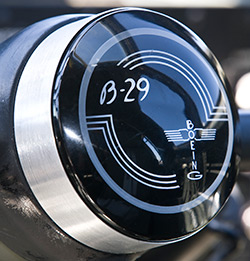 Two years later, the CAF invited Brig. Gen. Paul Tibbets to requalify as an aircraft commander aboard its B–29.
Two years later, the CAF invited Brig. Gen. Paul Tibbets to requalify as an aircraft commander aboard its B–29.
In 2005 FIFI’s engines began “making metal,” and the difficult decision was made to ground the airplane and reengine it with cooler-running hybrids (by combining the R-3350-95W with the -26WD). This project took two years, and the $1.2 million expense was paid largely by Jim Cavanaugh, owner of the Cavanaugh Flight Museum in Addison, Texas. FIFI flew again on August 6, 2010, returned to the airshow circuit, and remains the world’s only flyable Superfortress. FIFI’s engines are named Ingrid, Mitzi, Rita, and Betty. (You know their last names.)
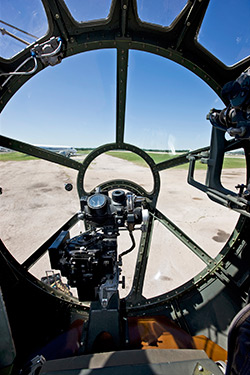 The Enola Gay passed over Saipan while cruising at 4,700 feet. Safely airborne, the “weaponeer,” William “Deak” Parsons, descended into the unpressurized forward bomb bay to arm the device code-named Little Boy, a misnomer if there ever was one. Coated with dull gunmetal paint and described by Tibbets as an “ugly monster,” the 12-foot-long bomb was adorned with handwritten messages for Japanese Emperor Hirohito.
The Enola Gay passed over Saipan while cruising at 4,700 feet. Safely airborne, the “weaponeer,” William “Deak” Parsons, descended into the unpressurized forward bomb bay to arm the device code-named Little Boy, a misnomer if there ever was one. Coated with dull gunmetal paint and described by Tibbets as an “ugly monster,” the 12-foot-long bomb was adorned with handwritten messages for Japanese Emperor Hirohito.
Six other B–29s were involved in the operation. Three were sent ahead to report on weather conditions at the target and two alternates. (The mission required visual conditions.) Two others escorted the Enola Gay. One was a photo plane, and the other carried scientists and an assortment of instrument packages that would be dropped by parachute to take scientific measurements. The seventh B–29 stood by at Iwo Jima in case Tibbets’ airplane had mechanical difficulties.
The sun rose before the Enola Gay arrived over Iwo Jima for a rendezvous with the two escorts. The bombers circled Mount Suribachi at 9,300 feet and set a northerly course for Japan. They maintained this altitude until an hour from the target and then climbed to 30,700 feet.
My training in NX529B was provided by Charlie Tilghman, a retired Southwest Airlines captain and designated examiner for the B–29 and other warbirds.
The big Boeing was one of the earliest airplanes to have a glass cockpit, and I’m not referring to avionics. The airplane’s distinctive glass nose envelops the cockpit and turns the flight deck into a hot greenhouse, even on a cool day.
Each pilot station has its own instrument panel containing little more than essential flight instruments. Almost all engine- and systems-related instruments and controls are on the flight engineer’s panel (although the aircraft commander’s panel also has a duplicate set of tachometers and manifold pressure gauges). The engineer does most of the work on this airplane, including engine start and runup. The pilot simply flies the airplane.
 There are three sets of throttles, one each for the aircraft commander, co-pilot, and engineer. The engineer’s throttles and mixture controls, however, are arranged 4-3-2-1, the same order as the engines for a person sitting backwards. An aisle stand between the pilots contains propeller-feathering controls, emergency brakes, and other items. The cowl flaps are so large and create so much drag that they are open only partially for takeoff. Otherwise they would disturb airflow across the wing, cause the airplane to buffet, and exact an intolerable performance penalty. Huge, slow-moving Fowler flaps extend aft to increase wing area and then drop conventionally. To improve cruise efficiency, they are extended five degrees above 25,000 feet and 10 degrees above 30,000.
There are three sets of throttles, one each for the aircraft commander, co-pilot, and engineer. The engineer’s throttles and mixture controls, however, are arranged 4-3-2-1, the same order as the engines for a person sitting backwards. An aisle stand between the pilots contains propeller-feathering controls, emergency brakes, and other items. The cowl flaps are so large and create so much drag that they are open only partially for takeoff. Otherwise they would disturb airflow across the wing, cause the airplane to buffet, and exact an intolerable performance penalty. Huge, slow-moving Fowler flaps extend aft to increase wing area and then drop conventionally. To improve cruise efficiency, they are extended five degrees above 25,000 feet and 10 degrees above 30,000.
The CAF has modified FIFI to make her safer, more reliable, and less expensive to operate. This involved stripping the airplane of armor plating, pressurization and air-conditioning systems, the oxygen system, deicing equipment, turbochargers, the oil-dilution system, the fuel-transfer system, center fuel tanks, and the autopilot. The airplane is not flown above 10,000 feet.
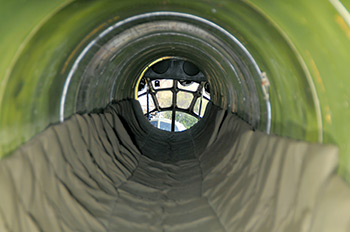 On August 17, 1942, Paul Warfield Tibbets commanded the lead B–17 Flying Fortress during the Eighth Air Force’s first bombing mission in Europe. He was a highly experienced bomber pilot when assigned to organize in Grand Island, Nebraska, the school that would train B-29 instructors. Unfortunately, pilots were reluctant to volunteer for duty on the new Superfortress. The airplane had a reputation for being difficult to fly. It also had engines that overheated easily. Engine fires fed by the magnesium used to lighten the crankcases reportedly were so intense they could sever a wing.
On August 17, 1942, Paul Warfield Tibbets commanded the lead B–17 Flying Fortress during the Eighth Air Force’s first bombing mission in Europe. He was a highly experienced bomber pilot when assigned to organize in Grand Island, Nebraska, the school that would train B-29 instructors. Unfortunately, pilots were reluctant to volunteer for duty on the new Superfortress. The airplane had a reputation for being difficult to fly. It also had engines that overheated easily. Engine fires fed by the magnesium used to lighten the crankcases reportedly were so intense they could sever a wing.
Tibbets overcame the shortage of volunteers by training two members of the Women Airforce Service Pilots (WASP) to fly a B–29, women who had never before flown a four-engine airplane. During their flight test, two engines had been shut down when the cockpit filled with smoke from an engine fire. Dora Dougherty and Dorothea Moorman handled the emergency without assistance and returned to the airport for a safe landing. This convinced male pilots that the airplane was not such a “beast” after all. (Dougherty and Moorman were the only women ever to check out in a B–29.)
Based on his experience and demonstrated leadership, Tibbets was later selected to organize and command the 1,800-man 509th Composite Group in Wendover, Utah, where he would train B–29 crews for a top-secret operation involving something called the Manhattan Project. He opted to command the first mission, saying that “if any mistakes would be made, I would make them.”
With the city shimmering in sunlight, Tibbets asked his crew, “Do we all agree that this is Hiroshima?” The aiming point was a bridge near the heart of the city. Crewmembers donned goggles with polarized lenses to protect themselves from a flash predicted to be 10 times the intensity of the sun.
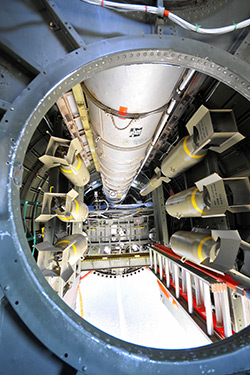 The bomb bay doors opened and at 0815:17 local time, the bombardier, Thomas Ferebee, released the 9,700-pound device from the forward bomb bay. The aircraft “pitched sharply nose-up,” and Tibbets later commented that it felt as though he had been “slapped hard on [his] ass.” (When multiple bombs were released from a B–29 during conventional bombing, they were dropped alternately from each bomb bay to prevent adverse shifting of the airplane’s center of gravity.)
The bomb bay doors opened and at 0815:17 local time, the bombardier, Thomas Ferebee, released the 9,700-pound device from the forward bomb bay. The aircraft “pitched sharply nose-up,” and Tibbets later commented that it felt as though he had been “slapped hard on [his] ass.” (When multiple bombs were released from a B–29 during conventional bombing, they were dropped alternately from each bomb bay to prevent adverse shifting of the airplane’s center of gravity.)
The device would reach its detonation altitude of 1,890 feet agl in 83 seconds. In that brief time, Tibbets had to get the Enola Gay at least eight slant-miles from the blast. Using an escape maneuver he had practiced many times over Utah, he muscled the airplane into a 60-degree-bank, 155-degree right turn. He lost 1,700 feet in the process and leveled off heading directly away from the target at maximum power. This left his tail gunner, George Caron, with the best view of a sight “beyond imagination.”
Shock waves caught up with and buffeted the Superfortress at a distance of 11.5 miles from the detonation. Tibbets said that he tasted lead in his mouth and felt electricity coursing through the fillings in his teeth, the result of radioactive electrolysis.
The Enola Gay touched down at 2:58 p.m. on the same runway but in a different world than the one from which it had departed 12 hours earlier.
Without boosted controls, you would expect the controls to be heavy, but you’d be wrong. They are beyond heavy. To provide the mechanical advantage needed to operate the ailerons, the control wheel turns more than 180 degrees in each direction. If a given deflection of the ailerons required less wheel movement, even more muscle would be required. In any event, roll rate is sluggish. So much rudder travel is needed to combat adverse yaw that you feel as though you are operating an elliptical machine at the gym. Flying FIFI in turbulence is fatiguing.
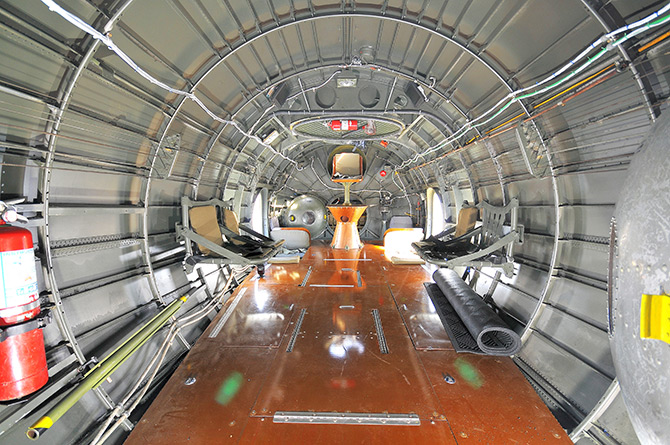 The military used 2,200 horsepower per engine for takeoff, but the CAF uses only 2,000. Because FIFI is never operated at more than 110,000 pounds (compared to the military maximum of 140,000), takeoff and climb performance are much improved. The relatively low takeoff power setting of 44 inches manifold absolute pressure (MAP) and 2,400 rpm keeps the engines cool and increases their longevity. For flight-planning purposes, FIFI consumes 400 gallons of fuel per hour.
The military used 2,200 horsepower per engine for takeoff, but the CAF uses only 2,000. Because FIFI is never operated at more than 110,000 pounds (compared to the military maximum of 140,000), takeoff and climb performance are much improved. The relatively low takeoff power setting of 44 inches manifold absolute pressure (MAP) and 2,400 rpm keeps the engines cool and increases their longevity. For flight-planning purposes, FIFI consumes 400 gallons of fuel per hour.
An unusual aspect of landing is that the glass nose lures you into focusing toward the center of the nose. You must instead make a deliberate effort to look straight ahead and farther down the runway to keep the airplane lined up with the centerline. And no matter which way you look, there always seems to be a strip of window framing in your way.
Final approach speed is typically 120 mph, with touchdown occurring at 95 to 100 mph. Be careful about banking aggressively during crosswind operations—ground clearance for the inboard propellers is only 14 inches.
Country singer Aaron Tippen and Commerative Air Force president Steve Brown sat with AOPA Pilot Editor in Chief Tom Haines in the cockpit of the worlds only flying B-29 Superfortress, FIFI.
With gratitude to the Commemorative Air Force, the B–29 Superfortress, an icon of American air power, is being saved from extinction, an ongoing and expensive challenge. FIFI is a vital reminder of those who flew this instrument of war and made the ultimate sacrifice battling tyranny and defending freedom.
Just touching or walking through the airplane is a privilege, an honor, a gesture of respect to those who fought an earlier Axis of Evil. Beyond that, you can purchase a ride in the airplane. It would be an emotional experience you will never forget.
Additional information about FIFI (including videos) is online. Further information about the Commemorative Air Force is also online.
